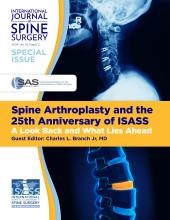ABSTRACT
Study Design Retrospective cohort study.
Objective To compare outcomes and complications of stand-alone minimally invasive lateral interbody fusion (LIF) vs revision posterior surgery for the treatment of lumbar adjacent segment disease.
Methods Adults who underwent LIF or transforaminal lumbar interbody fusion (TLIF) for adjacent segment disease were compared. Exclusion criteria: >grade 1 spondylolisthesis, posterior approach after LIF, and L5/S1 surgery. Patient demographics, estimated blood loss, hospital length of stay, complications, reoperations, health-related quality of life measures, and radiographs were examined. Data were analyzed with the χ2, Wilcoxon signed rank, and Mann-Whitney U tests.
Results A total of 17 LIF and 16 TLIF patients were included. Demographics were similar. Follow up was similar (LIF: 22.9 ± 11.8 months vs TLIF: 22.0 ± 4.6 months; P = .86). The LIF patients had significantly less blood loss (LIF: 36 ± 16 mL vs TLIF: 700 ± 767 mL; P < .001) and shorter length of stay (LIF: 2.6 ± 2.9 days vs TLIF: 3.3 ± 0.9 days; P = .001). There were no intraoperative complications. Revision rate was 4 of 17 in LIF and 3 of 16 in TLIF (P = .73). Baseline health-related quality of life and radiographic measurements were similar. In both groups, back and leg pain scores significantly improved, and in LIF, the Owestry Disability Index, and EuroQol-5D significantly improved. The LIF had a significant increase in intervertebral height (LIF: 4.8 ± 2.9 mm, P < .001, TLIF: 1.3 ± 3.4 mm, P = .37), which was significantly greater for LIF than TLIF (P = .002). Similarly, LIF had a significant increase in segmental lordosis (LIF: 5.6° ± 4.9°, P < .001, TLIF: 3.6° ± 8.6°, P = .16), which was not significantly different between groups.
Conclusions Patients with adjacent segment disease may receive significant benefit from stand-alone LIF or TLIF. The LIF offers advantages of less blood loss and a shorter hospital stay.
Level of Evidence 3
- lateral interbody fusion
- minimally invasive
- adjacent segment disease
- transforaminal lumbar interbody fusion
Footnotes
Disclosures and COI: The authors received no funding for this study and report no conflicts of interest.
- ©International Society for the Advancement of Spine Surgery







